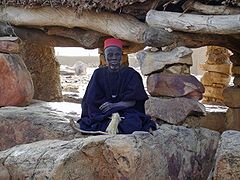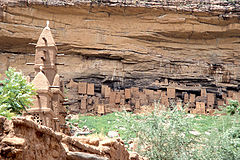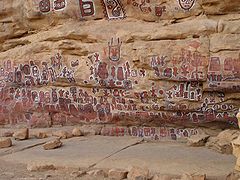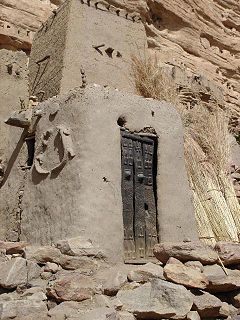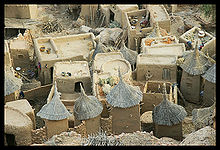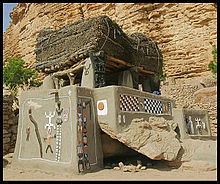- Dogon people
-
Dogon people 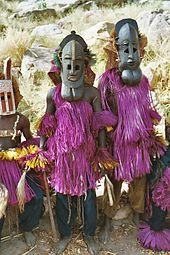
Dogon people, MaliTotal population 400,000 to 800,000 Regions with significant populations Mali[1] Burkina Faso[1] Languages The Dogon are an ethnic group living in the central plateau region of Mali, south of the Niger bend near the city of Bandiagara in the Mopti region. The population numbers between 400,000 and 800,000[1] The Dogon are best known for their religious traditions, their mask dances, wooden sculpture and their architecture. The past century has seen significant changes in the social organization, material culture and beliefs of the Dogon, partly because Dogon country is one of Mali's major tourist attractions.
Contents
Geography and history
The principal Dogon area is bisected by the Bandiagara Escarpment, a sandstone cliff of up to 500m (1,640 ft) high, stretching about 150 km (almost 100 miles). To the southeast of the cliff, the sandy Séno-Gondo Plains are found, and northwest of the cliff are the Bandiagara Highlands. Historically, Dogon villages were established in the Bandiagara area in consequence of the Dogon people's collective refusal to convert to Islam a thousand years ago.[2] Dogon insecurity in the face of these historical pressures caused them to locate their villages in defensible positions along the walls of the escarpment. The other factor influencing their choice of settlement location is water. The Niger River is nearby and in the sandstone rock, a rivulet runs at the foot of the cliff at the lowest point of the area during the wet season.
Among the Dogon several oral traditions have been recorded as to their origin. One relates to their coming from Mande, located to the southwest of the Bandiagara escarpment near Bamako. According to this oral tradition, the first Dogon settlement was established in the extreme southwest of the escarpment at Kani-Na.[3][4] Over time the Dogon moved north along the escarpment, arriving in the Sanga region in the 15th century.[5] Other oral histories place the origin of the Dogon to the west beyond the river Niger, or tell of the Dogon coming from the east. It is likely that the Dogon of today combine several groups of diverse origin who migrated to escape Islamization.[6]
Islamic law classified them and many other ethnicities of the region, (Mossi, Gurma, Bobo, Busa and the Yoruba) as being within the dar al-harb and consequently fair game for slave raids organized by merchants, though it is often difficult to distinguish between pre-Muslim practices and later Islamic practice[7] as the growth of cities increased the demand for slaves across the region of West Africa. The historical pattern has included the murder of indigenous males by Islamic raiders and enslavement of women and children.[8]
Dogon art
Dogon art is primarily sculpture. Dogon art revolves around religious values, ideals, and freedoms (Laude, 19). Dogon sculptures are not made to be seen publicly, and are commonly hidden from the public eye within the houses of families, sanctuaries, or kept with the Hogon (Laude, 20). The importance of secrecy is due to the symbolic meaning behind the pieces and the process by which they are made.
Themes found throughout Dogon sculpture consist of figures with raised arms, superimposed bearded figures, horsemen, stools with caryatids, women with children, figures covering their faces, women grinding pearl millet, women bearing vessels on their heads, donkeys bearing cups, musicians, dogs, quadruped-shaped troughs or benches, figures bending from the waist, mirror-images,roned figures, and standing figures (Laude, 46-52). Signs of other contacts and origins are evident in Dogon art. The Dogon people were not the first inhabitants of the cliffs of Bandiagara. Influence from Tellem art is evident in Dogon art because of its rectilinear designs (Laude, 24).
Culture and religion
The majority of Dogon practice an animist religion, including the ancestral spirit Nommo, with its festivals and a sect in which Sirius plays an important part. A significant minority of the Dogon practice Islam, another minority practice Christianity.
The Dogon record their ancestry through a patrilineal system. Each Dogon community, or enlarged family, is headed by one male elder. This chief head is the oldest living son of the ancestor of the local branch of the family. According to the NECEP database, within this patrilineal system polygynous marriages with up to four wives can occur.
Most men, however, have only one wife, and it is rare for a man to have more than two wives. Formally, wives only join their husband's household after the birth of their first child. Women may leave their husbands early in their marriage, before the birth of their first child. After having children, divorce is a rare and serious matter, and it requires the participation of the whole village. An enlarged family can count up to hundred persons and is called guinna.
The Dogon are strongly oriented toward harmony, which is reflected in many of their rituals. For instance, in one of their most important rituals, the women praise the men, the men thank the women, the young express appreciation for the old, and the old recognize the contributions of the young. Another example is the custom of elaborate greetings whenever one Dogon meets another. This custom is repeated over and over, throughout a Dogon village, all day. During a greeting ritual, the person who has entered the contact answers a series of questions about his or her whole family, from the person who was already there. Invariably, the answer is sewa, which means that everything is fine. Then the Dogon who has entered the contact repeats the ritual, asking the resident how his or her whole family is. Because the word sewa is so commonly repeated throughout a Dogon village, neighboring peoples have dubbed the Dogon the sewa people.
The Hogon is the spiritual leader of the village. He is elected between the oldest men of the enlarged families of the village. After his election he has to follow a six-month initiation period, during which he is not allowed to shave or wash. He wears white clothes and nobody is allowed to touch him. A young virgin that has not yet had her period takes care of him, cleans the house and prepares his meals. She returns to her home at night.
After his initiation, he will wear a red fez. He has an armband with a sacred pearl that symbolises his function. The virgin is replaced by one of his wives, but she also returns to her home at night. The Hogon has to live alone in his house. The Dogon believe the sacred snake Lébé comes during the night to clean him and to transfer wisdom.
The Dogon maintain an agricultural mode of subsistence, and cultivate pearl millet, sorghum and rice, as well as onions, tobacco, peanuts, and some other vegetables. Marcel Griaule stimulated the construction of a dam near Sangha and incited the Dogon to cultivate onions. The economy of the Sangha region doubled since then and its onions are sold as far as the market of Bamako and even Ivory Coast. They also raise sheep, goats and chickens. Grain is stored in granaries.
Circumcision
In Dogon thought, male and females are thought to be born with both sexual components. The clitoris is considered male, while the Foreskin is considered to be female.[9] Rites of circumcision thus allow each sex to assume its proper physical identity. Boys are circumcised in age groups of three years, counting for example all boys between 9 and 12 years old. This marks the end of their youth, and they are now initiated. The blacksmith performs the circumcision. Afterwards, they stay for a few days in a hut separated from the rest of the village people, until the wound has healed. The circumcision is a reason for celebration and the initiated boys go around and receive presents. They make music on a special instrument that is made of a rod of wood and calabashes that makes the sound of a rattle. The village of Songho has a circumcision cave ornamented with red and white rock paintings of animals and plants. Nearby is a cave where music instruments are stored. The newly circumcised men must walk around naked for a month after the procedure so that their achievement in age can be admired by the citizens of the tribe. This practice has been passed down for generations and is always followed, even during winter.
They are one of several African ethnic groups which practice female genital cutting. According to Sékou Ogobara Dolo, at least in the Sangha region, the milder form is practiced. This means that only the clitoral hood is removed, which is similar to male circumcision. The majority of the Dogon women practice a Class 2 circumcision, meaning that both the clitoris and the labia minora are removed. Girls are circumcised around the age of 7 or 8 years, sometimes younger. Circumcision for both male and female is seen as necessary for the individual to gain gender. Before circumcision they are seen as 'neuter'.
Funeral Masquerade
Due to the expense, their traditional funeral rituals or "damas" are becoming very rare. They may be performed years after the death. Damas that are still performed today are not usually performed for their original intent, but instead are done as a source of entertainment for tourists interested in the Dogon way of life. The Dogon use this entertainment to gain profit by charging the tourists money for what masks they want to see and the ritual itself (Davis, 68). The traditional dama consists of a masquerade that essentially leads the souls of the departed to their final resting places through a series of ritual dances and rites. Dogon damas include the use of many masks which they wore by securing them in their teeth, and statuettes. Each Dogon village may differ in the designs of the masks used in the dama ritual. Every village may have their own way of performing the dama rituals. The dama consists of an event, known as the Halic, immediately after the death of a person and lasts for one day (Davis, 68). According to Shawn R. Davis, this particular ritual incorporates the elements of the yingim and the danyim. During the yincomoli ceremony, a gourd is smashed over the deceased’s wooden bowl, hoe, and bundukamba, (burial blanket), which announces the entrance of the masks used in this ceremony while the deceased entrance to their home in the family compound is decorated with ritual elements (Davis, 72-73). Masks used during the yincomoli ceremony include the Yana Gulay mask, the Satimbe mask, the Sirigie mask, and the Kanaga mask. The Yana Gulay mask’s purpose is to impersonate a Fulani woman and is made from cotton cloth and cowell shells. The Satimbe mask represents the women ancestors who are said to have discovered the purpose of the masks by guiding the spirits of the deceased into the afterlife. (Davis, 74) The Sirigie mask is a tall mask that is only used in funerals for the men that were alive during the holding of the Sigui ceremony (see below) (Davis, 68). The Kanaga masqueraders, at one point, dance and sit next to the bundkamba which represents the deceased.
The yingim and the danyim rituals each last a few days. These events are held annually to honor the elders that have died since the last Dama. The yingim consists of the sacrifice of cows, or other valuable animals, and large mock battles performed in order to help chase the spirit, known as the nyama, from the deceased body and village and towards the path to the afterlife (Davis, 68). The danyim then takes place a couple of months later. During the danyim, masqueraders perform dances every morning and evening for anytime up to six days depending on how that village performs this ritual. The masqueraders dance on the deceased’s rooftops, throughout the village, and the area of fields around the village (Davis, 68). Until the masqueraders have completed their dances and every ritual has been performed, it is said that any misfortune can be blamed on the remaining spirits of the dead (Davis, 68).
Sects
Dogon society is composed of several different sects:
- The Amma sect: worships the highest creator god Amma. The celebration is once a year and consists of offering boiled millet on the conical altar of Amma, colouring it white. All other sects are directed to the god Amma.
- Sigui: the most important ceremony of the Dogon. It takes place every 60 years and can take several years. The last one started in 1967 and ended in 1973, the next one will start in 2027. The Sigui ceremony symbolises the death of the first ancestor (not to be confused with Lébé) until the moment that humanity acquired the use of the spoken word. The Sigui is a long procession that starts and ends in the village of Youga Dogorou and goes from one village to the other during several months or years. All men wear masks and dance in long processions. The Sigui has a secret language, Sigui So, that women are not allowed to learn. The secret Society of Sigui plays a central role in the ceremony. They prepare the ceremonies a long time in advance, and they live for three months hidden outside of the villages while nobody is allowed to see them. The men from the Society of Sigui are called the Olubaru. The villagers are afraid of them and fear is cultivated by a prohibition to go out at night, when sounds warn that the Olubaru are out. The most important mask that plays a major role in the Sigui rituals is the Great Mask or the Mother of Masks. It is several meters long and is just held up by hand and not used to hide a face. This mask is newly created every 60 years.
- The Lébé sect: worships the ancestor Lébé Serou, the first mortal human being, who, in Dogon myth, was transformed into a snake. The celebration takes place once a year and lasts for three days. The altar is a pointed conic structure on which the Hogon offers boiled millet while mentioning in his benediction eight grains plus one. Afterwards, the Hogon performs some rituals in his house that is also the home of Lébé. The last day, all the village men visit all the Binou altars and dance three times around the Lébé altar. The Hogon invites everybody that assisted to drink the millet beer.
- The Binou sect: uses totems, common ones for the entire village and individual ones for totem priests. A totem animal is worshipped on a Binou altar. Totems are for example the buffalo for Ogol-du-Haut, and the panther for Ogol-du-Bas. Normally, nobody will ever be harmed by its own totem animal, even if this is a crocodile as for the village of Amani. Here is a large pool of crocodiles that do not harm any villager. However, a totem animal might exceptionally harm if one has done something wrong. A worshipper is not allowed to eat his totem. For example, an individual with a buffalo as totem is not allowed to eat buffalo meat, but also not to use leather from its skin and even not to see a buffalo die. If this happens by accident he has to organise a purification sacrifice at the Binou altar. Boiled millet is offered and goats and chickens are sacrificed on a Binou altar. This colours the altar both white and red. Binou altars look like little houses with a door. They are bigger when the altar is for an entire village. A village altar has also the ‘cloud hook’, that will catch clouds and make it rain.
- The twin sect: the birth of twins is a sign of good luck. The enlarged Dogon families have common rituals during which they evoke all their ancestors till their origin, the ancient pair of twins from the creation of the world belief.
- The Mono sect: the Mono altar is at the entry of every village. Unmarried young men celebrate the Mono sect once a year in January or February. They spend the night around the altar, singing and screaming and waving with fire torches. They hunt for mice that will be sacrificed on the altar at dawn.
Dogon villages
Dogon villages have different buildings:
- Male granary: storage place for pearl millet and other grains. Building with a pointed roof. This building is well protected from mice. The amount of filled male granaries is an indication for the size and the richness of a guinna.
- Female granary: storage place for a woman's things, her husband has no access. Building with a pointed roof. It looks like a male granary but is less protected against mice. Here, she stores her personal belongings such as clothes, jewelry, money and some food. A woman is economically independent and earnings and things related to her merchandise are stored in her personal granary. She can for example make cotton or pottery. The amount of female granaries is an indication for the amount of women living in the guinna.
- Tógu nà (a kind of case à palabres): a building only for men. They rest here much of the day throughout the heat of the dry season, discuss affairs and take important decisions in the toguna.[10] The roof of a toguna is made by 8 layers of millet stalks. It is a low building in which one cannot stand upright. This helps avoiding violence when discussions get heated.
- House for menstruating women: this house is on the outside of the village. It is constructed by women and is of lower quality than the other village buildings. Women having their period are considered to be unclean and have to leave their family house to live during five days in this house. They use kitchen equipment only to be used here. They bring with them their youngest children. This house is a gathering place for women during the evening. This hut is also thought to have some sort of reproductive symbology due to the fact that the hut can be easily seen by the men who are working the fields who know that only women who are on their period, and thus not pregnant, can be there.
Languages
Main article: Dogon languagesDogon has been frequently referred to as a single language. In reality, there are at least five distinct groups of dialects. The most ancient dialects being dyamsay and tombo, the former being most frequently used for traditional prayers and ritual chants. The Dogon language family is internally highly diverse, and many varieties are not mutually intelligible, actually amounting to some 12 dialects and 50 sub-dialects. There is also a secret ritual language sigi sǫ (language of Sigi), which is taught to dignitaries (olubarū) of the Society of the Masks during their enthronement at the Sigui ceremony..,[11][12] Women have no right to learn Sigui So.
It is generally accepted that the Dogon languages belong to the Niger–Congo language family, though the evidence is weak. They have been linked to the Mande subfamily but also to Gur. In a recent overview of the Niger–Congo phylum, Dogon is treated as an independent branch.[13]
The Dogon languages show few remnants of a noun class system (one example is that human nouns take a distinct plural suffix), leading linguists to conclude that Dogon is likely to have diverged from Niger–Congo very early. Another indication of this is the subject–object–verb basic word order, which Dogon shares with such early Niger–Congo branches as Ijoid and Mande.
Dogon and Sirius
Certain researchers investigating the Dogon have reported that they seem to possess advanced astronomical knowledge, the nature and source of which has subsequently become embroiled in controversy. From 1931 to 1956 the French anthropologist Marcel Griaule studied the Dogon. This included field missions ranging from several days to two months in 1931, 1935, 1937 and 1938[14] and then annually from 1946 until 1956.[15] In late 1946 Griaule spent a consecutive thirty-three days in conversations with the Dogon wiseman Ogotemmêli, the source of much of Griaule and Dieterlen's future publications.[16] They reported that the Dogon believe that the brightest star in the sky, Sirius (sigi tolo or 'star of the Sigui'[17]), has two companion stars, pō tolo (the Digitaria star), and ęmmę ya tolo, (the female Sorghum star), respectively the first and second companions of Sirius A.[18] Sirius, in the Dogon system, formed one of the foci for the orbit of a tiny star, the companionate Digitaria star. When Digitaria is closest to Sirius, that star brightens: when it is farthest from Sirius, it gives off a twinkling effect that suggests to the observer several stars. The orbit cycle takes 60 years.[19] They also claimed that the Dogon appeared to know of the rings of Saturn, and the moons of Jupiter.[20]
Griaule and Dieterlen were puzzled by this Sudanese star system, and prefaced their analysis with the following remark:-
-
The problem of knowing how, with no instruments at their disposal, men could know the movements and certain characteristics of virtually invisible stars has not been settled, nor even posed.[21]
In 1976 Robert K. G. Temple wrote a book called The Sirius Mystery arguing that the Dogon's system reveals precise knowledge of cosmological facts only known by the development of modern astronomy, since they appear to know, from Griaule and Dieterlen's account, that Sirius was part of a binary star system, whose second star, Sirius B, a white dwarf, was however completely invisible to the human eye, (just as Digitaria is the smallest grain known to the Dogon), and that it took 50 years to complete its orbit. The existence of Sirius B had only been inferred to exist through mathematical calculations undertaken by Friedrich Bessel in 1844. Temple then argued that the Dogon's information, if traced back to ancient Egyptian sources and myth, indicated an extraterrestrial transmission of knowledge of the stars.[22] Neither Griaule nor Dieterlen had ever made such bold claims about a putative esoteric source for the Dogon's knowledge.
More recently, doubts have been raised about the validity of Griaule and Dieterlein's work.[23][24] In a 1991 article in Current Anthropology anthropologist Walter van Beek concluded after his research among the Dogon that,
"Though they do speak about sigu tolo [which is what Griaule claimed the Dogon called Sirius] they disagree completely with each other as to which star is meant; for some it is an invisible star that should rise to announce the sigu [festival], for another it is Venus that, through a different position, appears as sigu tolo. All agree, however, that they learned about the star from Griaule"[25]
Griaule's daughter Genevieve Calame-Griaule responded in a later issue, arguing that Van Beek did not go "through the appropriate steps for acquiring knowledge" and suggesting that van Beek's Dogon informants may have thought that he had been "sent by the political and administrative authorities to test the Dogon's Muslim orthodoxy." [26] An independent assessment is given by Andrew Apter of the University of California.[27]
In his book Sirius Matters, Noah Brosch postulates that the Dogon may have had contact with astronomers based in Dogon territory during a five week expedition, led by Henri-Alexandre Deslandres, to study the solar eclipse of April 16, 1893.[28] Robert Todd Carroll also states that a more likely source of the knowledge of the Sirius star system is from contemporary, terrestrial sources who provided information to interested members of the tribes.[29] James Oberg however, citing these suspicions notes their completely speculative nature, writing that: "The obviously advanced astronomical knowledge must have come from somewhere, but is it an ancient bequest or a modern graft? Although Temple fails to prove its antiquity, the evidence for the recent acquisition of the information is still entirely circumstantial.".[30] Additionally, James Clifford notes that Griaule sought informants best qualified to speak of traditional lore, and deeply mistrusted converts to Christianity, Islam, or people with too much contact with whites.[31] Oberg points out a number of errors contained in the Dogon beliefs, including the number of moons possessed by Jupiter, that Saturn was the furthest planet from the sun, and the only planet with rings. Intrigue of other seemingly falsifiable claims, namely concerning a red dwarf star orbiting around Sirius (not hypothesized until the 1950s) led him to entertain a previous challenge of Temple's:
"Temple offered another line of reasoning. "We have in the Dogon information a predictive mechanism which it is our duty to test, regardless of our preconceptions." One example: "If a Sirius-C is ever discovered and found to be a red dwarf, I will conclude that the Dogon information has been fully validated." (OK, I'll bite—but if such a star is not discovered, Temple has risked no converse conclusions.)"
This alludes to reports that the Dogon knew of another star in the Sirius system, Emme Ya, or a star "larger than Sirus B but lighter and dim in magnitude." In 1995, gravitational studies indeed showed the possible presence of a brown dwarf star orbiting around Sirius (a Sirius-C) with a six-year orbital period.[32] A more recent study using advanced infrared imaging concluded the probability of existence of a triple star system for Sirius is "now low" but could not be ruled out because the region within 5 AU of Sirius A had not been covered.[33]
Footnotes
- ^ a b c http://www.necep.net/facts.php?id_soc=12
- ^ Marcel Griaule, Germaine Dieterlen, le renard pâle, Institut d'Ethnologie Musée de l'homme, Paris 1965, Tome 1: -Le mythe cosmologique p.17
- ^ Dieterlen, G., 1955. Mythes et organisation sociale au Soudan franc¸ais. Journal de la Socie´te´ des Africanistes 25 (1/2), 39–76.
- ^ http://www.sciencedirect.com/science?_ob=ArticleURL&_udi=B6WH6-4F9N71F-1&_user=130907&_rdoc=1&_fmt=&_orig=search&_sort=d&_docanchor=&view=c&_searchStrId=1014077024&_rerunOrigin=scholar.google&_acct=C000004198&_version=1&_urlVersion=0&_userid=130907&md5=7ba34d633f95fb1e7257ee1acb74b42c, Population dynamics and Paleoclimate over the past 3000 years in the Dogon Country, Mali
- ^ Griaule, M. 1938 Masques dogons. Paris.
- ^ Morton, Robert (ed.) & Hollyman, Stephenie (photographs) & Walter E.A. van Beek (text) (2001) Dogon: Africa's people of the cliffs. New York: Abrams. ISBN 0-8109-4373-5
- ^ Timothy Insoll, The Archaeology of Islam in Sub-Saharan Africa (2003) Cambridge University Press, p.308
- ^ Christopher Wise, Yambo Ouologuem: Postcolonial Writer, Islamic Militant, Published 1999, Lynne Rienner Publishers
- ^ Marcel Griaule, Conversations with Ogotemmêli: An introduction to Dogon Religious Ideas,International African Institute/Oxford University Press (1965) 1970 reprint pb.p.22. Originally, for the Dogon, man was endowed with a dual soul, and circumcision eliminates the superfluous one.(ibid.p.24)
- ^ Anne Doquet, Sory Camara, Les masques dogon:ethnologie savante et ethnologie autochtone, Karthala editions, 1999 p.253
- ^ Griaule, Dieterlin, le renard pâle,' ibid.pp.18-19
- ^ A very detailed recent study can be found in Hochstetler et al(2004)
- ^ Williamson and Blench (2000), p. 18.
- ^ Ciarcia, Gaetano “Dogons et Dogon. Retours au ‘pays du reel’”, L’Homme 157 (janvier/mars): 217-229. [1]
- ^ Imperato, Pascal James, Historical Dictionary of Mali Scarecrow Press, 1977 ISBN 9780810810051 p.53
- ^ Imbo, Samuel Oluoch, An Introduction to African Philosophy Rowman & Littlefield Publishers (28 Jun 1998) ISBN 978-0847688418 p.64 [2]
- ^ Sirius is also called albararu. See Griaule and Dieterlen. le renard pâle, ibid.p.514
- ^ Griaule and Dieterlen, le renard pâle, ibid.p.468,470,514
- ^ M.Griaule, G.Dieterlen, 'A Sudanese Sirius System' (trans. of the authors' paper, 'Un Système Soudanais de Sirius', Journal de la Société des Africainistes,' Tome XX, Fascicule 1, 1950 pp.273-94) in Robert Temple, 'Thew Sirius Mystery, (Sidgwick & Jackson),Futura Books, London 1976 pp.58-81,pp.64-5,p.68
- ^ M Griaule, G Dieterlen, The Dogon of the French Sudan (1948)
- ^ M.Griaule, G.Dieterlen, 'A Sudanese Sirius System', ibid,p.59
- ^ Robert K. G. Temple, The Sirius Mystery, 1975
- ^ Bernard R. Ortiz de Montellano. "The Dogon Revisited". http://www.ramtops.co.uk/dogon.html. Retrieved 2007-10-13.
- ^ Philip Coppens. "Dogon Shame". http://www.philipcoppens.com/dogonshame.html. Retrieved 2007-10-13.
- ^ van Beek, WAE; Bedaux; Blier; Bouju; Crawford; Douglas; Lane; Meillassoux (1991). "Dogon Restudied: A Field Evaluation of the Work of Marcel Griaule". Current Anthropology 32 (2): 139–67. doi:10.1086/203932. JSTOR 2743641.
- ^ Genevieve Calame-Griaule: "On the Dogon Restudied." Current Anthropology, Vol. 32, No. 5 (Dec., 1991), pp. 575-577
- ^ Andrew Apter, Cahiers d'Études africaines, XLV (1), 177, (2005), pp. 95-129. "Griaule’s Legacy: Rethinking "la parole claire" in Dogon Studies". http://www.sscnet.ucla.edu/history/apter/Cahiers.pdf.
- ^ Brosch, Noah (2008), Sirius Matters, Springer, p. 66, http://books.google.co.uk/books?id=ricStR4SE-UC, retrieved January 21, 2011
- ^ Carroll, RT (2003). The Skeptic's Dictionary: A Collection of Strange Beliefs, Amusing Deceptions, and Dangerous Delusions. John Wiley & Sons. pp. 104. ISBN 0471272426. http://books.google.com/?id=6FPqDFx40vYC&pg=PA104.
- ^ Oberg, J. "The Sirius Mystery". http://www.debunker.com/texts/dogon.html. Retrieved 2008-12-30.
- ^ James Clifford, ‘Power and Dialogue in Ethnography:Marcel Griaule’s initiation,’ in George W. Stocking (ed.) Observers observed: essays on ethnographic fieldwork, University of Wisconsin Press, 1983 pp. 121-156, p.137
- ^ Benest, D., & Duvent, J. L. (1995) "Is Sirius a triple star?". Astronomy and Astrophysics 299: 621-628
- ^ Bonnet-Bidaud, J. M.; Pantin, E. (October 2008). "ADONIS high contrast infrared imaging of Sirius-B". Astronomy and Astrophysics 489: 651–655. arXiv:0809.4871. Bibcode 2008A&A...489..651B. doi:10.1051/0004-6361:20078937.
References
People
- Marcel Griaule: Conversations With Ogotemmeli: An Introduction To Dogon Religious Ideas. 1st. ed. 1965. ISBN 0-19-519821-2
- Marcel Griaule: Dieu d'eau. Entretiens avec Ogotemmêli. (1966) Ed Fayard. ISBN 2-213-59847-9 (the original French work of Griaule (that was published in 1948) on his discussions with Ogotemmêli)
- Bedaux, R. & J.D. van der Waals (eds.) (2003) Dogon: mythe en werkelijkheid in Mali [Dogon: myth and reality in Mali]. Leiden: National Museum of Ethnology.
- Morton, Robert (ed.) & Hollyman, Stephenie (photographs) & Walter E.A. van Beek (text) (2001) Dogon: Africa's people of the cliffs. New York: Abrams. ISBN 0-8109-4373-5
- Wanono, Nadine & Renaudeau, Michel (1996) Les Dogon (photographs by Michel Renaudeau; text by Nadine Wanono). Paris: Éditions du Chêne-Hachette. ISBN 2-85108-937-4
- Eds. Petit Futé. Mali 2005-2006 ISBN 2-7469-1185-X
- Sékou Ogobara Dolo: La mère des masques. Un Dogon raconte. (2002) Eds. Seuil ISBN 2-02-041133-4
- Gerard Beaudoin: Les Dogon du Mali (1997) Ed. BDT Développement. ISBN 2-9511030-0-X
Language
- Bertho, J. (1953). "La place des dialectes dogon de la falaise de Bandiagara parmi les autres groupes linguistiques de la zone soudanaise". Bulletin de l'IFAN 15: 405–441.
- Hantgan, Abbie (2007) Dogon Languages and Linguistics An (sic) Comprehensive Annotated Bibliography
- Hochstetler, J. Lee, Durieux, J.A. & E.I.K. Durieux-Boon (2004) Sociolinguistic Survey of the Dogon Language Area. SIL International. online version
- Williamson, Kay & Blench, Roger (2000) 'Niger–Congo', in Heine, Bernd and Nurse, Derek (eds) African Languages - An Introduction. Cambridge: Cambridge University press, pp. 11–42.
Art
- Laude, Jean. African Art of the Dogon: The Myths of the Cliff Dwellers (New York: The Viking Press 1973).
- Davis , Shawn R. “Dogon Funerals” in African Art; Summer 2002, Vol. 35 Issue 2
External links
- Official tourism website for Dogon Country
- Griaule, Marcel and Dieterlen, Germaine (1954) "The Dogon", in African Worlds: Studies in the Cosmological Ideas and Social Values of African Peoples, edited by Daryll Forde
- Map of Dogon language(s) from the LL-Map Project
- Information about the Dogon language(s) from the MultiTree Project
- Photos of Dogon Country
- Pictures of Dogon Country
- Pictures of Dogon Country
- Pictures of Dogon Country
- Dogon images from the Smithsonian Institution Research Information System
Categories:- Dogon
- Ethnic groups in Mali
- Ethnic groups in Niger
- Ethnic groups in Africa
Wikimedia Foundation. 2010.



